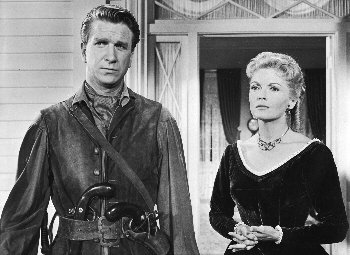Toon Talk: Walt Disney Treasures - Elfego Baca & The Swamp Fox and The Adventures of Spin & Marty
Page 1 of 4

A Review by Kirby C. Holt


(c) Disney
Elfego Baca & The Swamp Fox: Legendary Heroes
The Adventures of Spin & Marty
He-Men and the Masters of the Triple R
The phenomenal success of Davy Crockett in the mid-50’s was a hard act to follow, but Walt and his television staff rose to the occasion with more real American heroes to dramatize on their weekly anthology program (formerly Disneyland, by now under the title Walt Disney Presents). One of the recent installments of the celebrated Walt Disney Treasures series is devoted to two of these series, Elfego Baca & The Swamp Fox: Legendary Heroes.

(c) Disney
If these two characters are unfamiliar to you, you are not alone. Even long-time Disney fans may be unfamiliar with the adventures of these colorful swashbucklers (let alone having actually seen any of them), but once again Treasures host Leonard Maltin has dusted off what has been overlooked by time and presents it in all its deserved glory. Elfego and the Fox may not be as popularly revered as Davy was, but their exploits, seen rarely if at all in recent years, are no less entertaining.
The collection begins on disc one with the series based on Elfego Baca (1865-1945), a Mexican-American who lead the type of life most screenwriters could'nt dream up. A checkered past as an outlaw lead him to the job of sheriff which, in turn, spurred his interest in the law. He eventually became a lawyer who specialized in helping the “little people�?, namely his fellow Mexican-Americans.
In bringing this story to television, Walt, knowingly or not, introduced what was likely the first Mexican-American hero into the homes of America (at least those who had television sets). And although Italian-American actor Robert Loggia (who, of course, would go on to an illustrious film and TV career, including an Oscar nomination for Jagged Edge and a Disney villain in Oliver and Company) was cast as Baca - such inverse “color blind�? casting was not uncommon in those days - his performance is nonetheless quite effective. Allowing an accent that is thin in spots, the very young Loggia is very charismatic in the role and, having grown up in New York City, obviously relished the opportunity to play the proverbial hero of the ol’ west; just watch him grin from ear to ear every time he mounts a horse. Ethnic characters of any type were uncommon in these early days of television, and the fact that Baca was not only non-stereotypical, but also very much a role model (sure, he smoked, but who didn’t on TV then? Besides, he was a good Catholic ...) is quite the testament to the (consciously or not) forward thinking of the creators of the program.
Ten episodes of Elfego Baca were produced between 1958 and 1960, but only three (first, second and fifth) are included here. Although originally aired in black and white, Walt had the foresight to film in color, so aside from the opening titles and previews, all episodes in this set (and for The Swamp Fox as well) are in full color, including Walt’s original introductions to each episode (in the Baca segments, he’s even garbed, appropriately, in natty western wear).
The first Baca show, titled enigmatically “The Nine Lives of Elfego Baca�? (original airdate October 3, 1958), is the best; based directly on the incident that earned the real Baca such infamy, it sets the tone that carries throughout the remaining episodes. The plot is set in motion from the get-go when Baca is cornered in an adobe hut by an angry lynch mob; 33 hours, 4,000 bullets and some fire and dynamite later, Baca miraculously survives, therefore earning the reputation as the “man who could not be killed.�? What is most compelling about this scenario are its racial overtones: one Mexican-American against 80 Caucasians. In other words, the white guys were the enemy … quite amazing, in retrospect, considering this was a 1958 family program.
More material ahead of its time can be found in episode 2 (“Four Down and Five Lives to Go�?, original airdate October 17, 1958), which focuses on Baca’s unconventional approach to being a sheriff - such as throwing a live rattlesnake at his prey. The story has Baca tracking down a murderous fellow countryman, leading him to comment “men like him … give our people a bad name.�?
We then skip forward to episode 5 (“Attorney at Law�?, original airdate February 6, 1959) where we find that, although he is a lawyer now, Baca has not given up his sharp shootin’. I have a feeling that this episode was included not so much for the chance to see Baca do some lawyerin’, but because of guest star Annette Funicello, incongruously cast as a Mexican maiden name “Chiquita�? (thus joining the offensively named ranks of Linda Darnell’s “Chihuahua�? in John Ford’s My Darling Clementine); unlike Loggia, Annette doesn’t even attempt an accent.
Saddled at times with some clumsy dialogue, but blessed with impressive production values (a Disney mandate), Baca is a commendable western series just as exciting as its more “adult�? contemporaries, such as The Big Valley and Bonanza.
